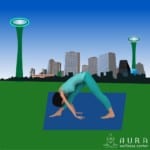 By: Virginia Iversen, M.Ed
By: Virginia Iversen, M.Ed
Teaching Yoga poses for anger management is very useful these days. As a certified Yoga teacher, you have the ability to facilitate deep transformational change in your students. This change can take the form of an overall increase in your students’ level of physical health, including greater strength, flexibility and weight loss. In addition, the transformational power of a regular, dedicated practice of Yoga can also help to improve your students’ mental outlook on life. Once you become quite familiar and comfortable with the correct alignment of many of the foundational asanas, you will be able to creatively sequence your classes, in order to help your students to maintain a positive mental outlook, as well as good overall fitness levels.
One of the ways that you can fully support your Yoga students’ overall health and well being, is by helping them to compassionately acknowledge and dissolve negative emotional states. A very common negative emotion for many of us is a low-grade feeling of agitation, annoyance or anger. At times, of course, this anger may be quite understandable and justified. At other times, this low-grade form of anger may spring from common, everyday situations, such as having to stand in a long line at the grocery store or being cut off in traffic. These everyday irritations are often held in the body by a process called, “somatization.”
When we experience negative emotions and unresolved painful experiences, the outcome is often deep-seated stress and muscular holding, which results in physical tension. Yoga poses for anger management can make a positive difference. This is where guiding your students through a comprehensive, well-rounded practice of Yoga poses for anger management can quite literally wring the stress and tension out of the body. If you include cleansing and calming pranayama exercises into your Yoga classes as well, you will further facilitate your students’ process of dissolving negative emotional states that cause physical tension, such as irritation, impatience and anger.
* Pyramid Pose or Parsvottanasana
Pyramid Pose is a very accessible beginning Yoga posture that helps to open up the front body. Anger and impatience often result in hunching up our shoulders, closing off the throat area and contracting or closing off the heart chakra area. Pyramid Pose helps to unravel all of these areas of physical tension. This posture also helps to elongate and stretch out the hamstring muscles, as it opens up the chest cavity and stimulates the abdominal area, which helps to increase the digestive fire. This beginning standing Yoga posture also helps to improve a student’s overall posture, sense of balance and coordination. Additionally, as the tension is dissolved from the shoulders, throat and chest areas, feeling of anger and irritation quite naturally begin to fall away. Since Pyramid Pose requires a Yoga student’s full attention to stay balanced and in correct alignment, this pose is also calming and focusing for the mind.
If any of your Yoga students need some additional balancing support while practicing Parsvottanasana, the use of a chair is recommended. Some of your students may also benefit from the use of a Yoga block if their hamstrings are particularly tight. Pyramid Pose is usually practiced after a series of Sun Salutations and some basic foundational standing asanas. This pose is optimally woven into a flowing series of standing and balancing Yoga postures, linked together by the breath. When you are teaching Pyramid Pose to your Yoga students, remember to ask them to fully extend backwards into the chest-expanding portion of this posture.
Although this pose seems deceptively simple, it is powerfully effective at expanding the front side of the entire chest area, including the front of the shoulders, neck, throat, and heart area. Classically, the hands are placed in Prayer Position just below the thoracic spine. If you have some students in your class who are unable to comfortably place their hands in Prayer Position behind their back while they hold Parsvottanasana, they may simply grasp their elbows or hold a strap, until they are able to enter more fully into this profoundly effective heart-opening and Yoga poses for anger management improve the quality of life.
© Copyright – Aura Wellness Center / Virginia Iversen – Publications Division
Subscribe to Our Newsletter for Special Discounts and New Products
See our testimonials to find out what our graduates have to say about our selection of affordable yoga teacher certification programs.
Related Resources
Kristen E. Riley, Crystal L. Park, Angela Wilson, Alex N. Sabo, Michael H. Antoni, Tosca D. Braun, John Harrington, Juliana Reiss, Edi Pasalis, Adam D. Harris, Stephen Cope. (2017) Improving physical and mental health in frontline mental health care providers: Yoga-based stress management versus cognitive behavioral stress management. Journal of Workplace Behavioral Health 32:1, pages 26-48.
Kaitlin N. Harkess, Paul Delfabbro, Sarah Cohen-Woods, Cornelia Duregger. (2016) The longitudinal mental health benefits of a yoga intervention in women experiencing chronic stress: A clinical trial. Cogent Psychology 3:1.
Brandi M. Crowe, Marieke Van Puymbroeck, Sandra M. Linder, Francis A. Mcguire, Paula J. Watt. (2015) The Effects of Yoga Participation on Women’s Quality of Life and Symptom Management During the Menopausal Transition: A Pilot Study. Health Care for Women International 36:10, pages 1124-1142.
Ana María Velásquez, María Adelaida López, Natalia Quiñonez, Diana Patricia Paba. (2015) Yoga for the prevention of depression, anxiety, and aggression and the promotion of socio-emotional competencies in school-aged children. Educational Research and Evaluation 21:5-6, pages 407-421.
by Leslie Kaminoff and Amy Matthews
52 Essential Principles of Yoga Philosophy to Deepen your Practice
by Rina Jakubowicz.
A Relaxing Way to De-stress, Re-energize, and Find Balance
by: Gail Boorstein Grossman.
YOGA: THE PATH TO HOLISTIC HEALTH
by B.K.S. Iyengar
TEACHING YOGA: Essential Foundations and Techniques
By Mark Stephens
